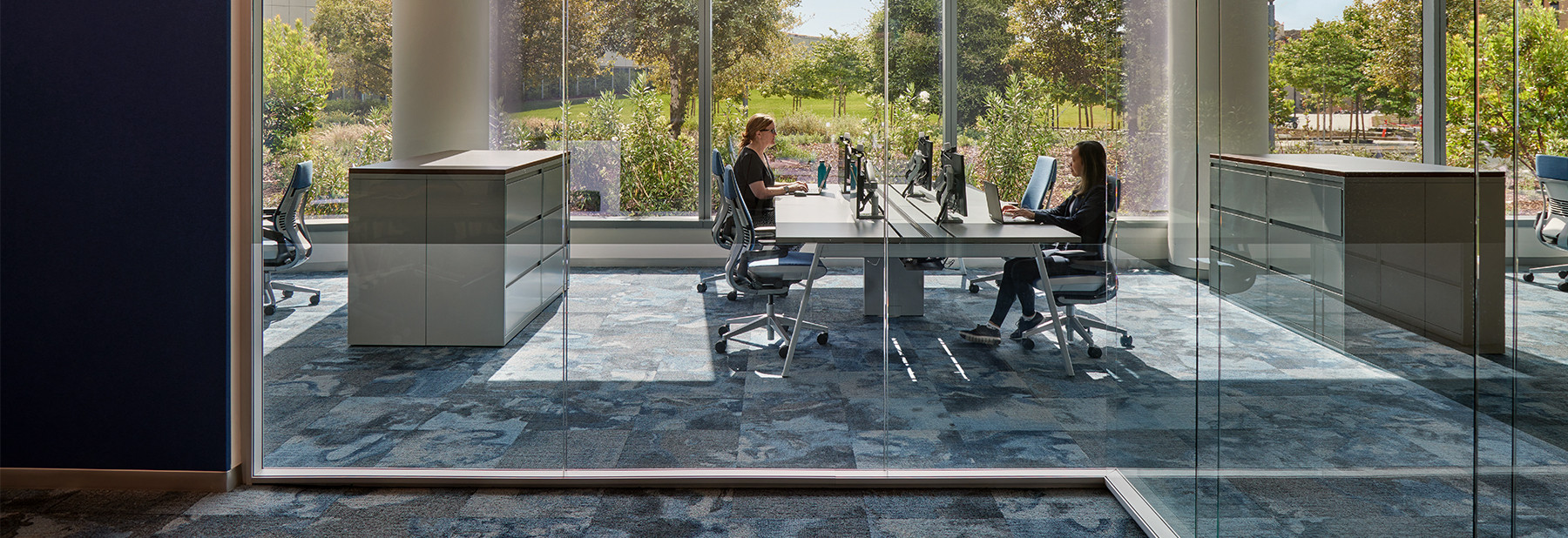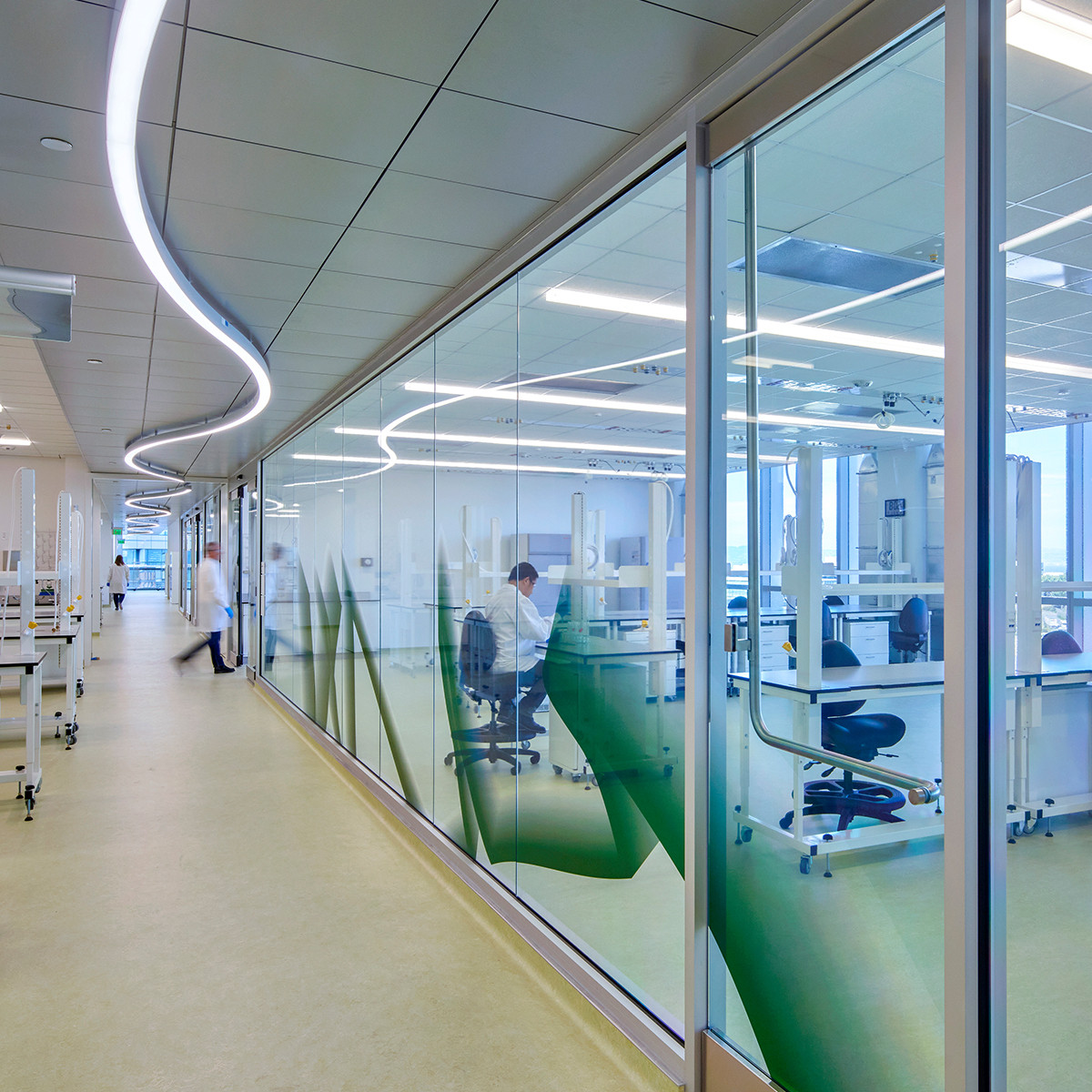
The rise of hybrid work has given many people the opportunity to personalize a home office to meet their specific needs and level of comfort, which in some cases has highlighted the benefits of a hospitable and comfortable workplace to productivity and employee mental and physical well-being.
Coupled with an urgency for sustainable practices, which strongly correlate with overall well-being, employers now face greater responsibility and higher expectations to provide a comfortable work environment. These stakes are especially high for scientific workplaces, where fully remote work is not often feasible and there is fierce competition to attract and retain highly skilled employees whose research tasks require focus and precision.
Scientific Workplace of the Future
Designing to Support Well-Being and Sustainability
The rise of hybrid work has given many people the opportunity to personalize a home office to meet their specific needs and level of comfort, which in some cases has highlighted the benefits of a hospitable and comfortable workplace to productivity and employee mental and physical well-being.
Coupled with an urgency for sustainable practices, which strongly correlate with overall well-being, employers now face greater responsibility and higher expectations to provide a comfortable work environment. These stakes are especially high for scientific workplaces, where fully remote work is not often feasible and there is fierce competition to attract and retain highly skilled employees whose research tasks require focus and precision.

What Defines Comfort in a Scientific Workplace?More than simply a desk or a lab bench with proper lighting and equipment, a comfortable work environment should be designed to holistically support employees' well-being. This includes physical, mental, and social needs, and each of these areas intersect with one another.
Whether a new build, renovation, or fit-out, it is crucial for the project teams, including client leadership and key stakeholders, to establish project goals for sustainability and well-being from the onset. Knowing these intentions will help to weave the necessary steps to achieve these goals into every step of the project and ensure they are part of the budget.
Returning to the idea of working from home, for many people, the benefits extended beyond wearing sweatpants to a meeting or avoiding the morning commute. It's opened our eyes to the positive mental results that come from being able to control physical aspects such as noise level, temperature, and lighting, not to mention easier access to a needed snack or hot meal. All of these factors can result in a better mental state and more productivity.
The same concepts can and should be brought to the in-person office and laboratory. They are also the basis for workplace wellness certifications such as WELL and Fitwel, which provide the opportunity to quantify and improve these factors that contribute to well-being. This includes the most basic human needs such as access to clean air and water, availability of nutritious food, and support of physical movement, as well as broader concepts such as community health, among others.
Wellness and SustainabilityThese concepts are also congruent with LEED and other sustainability certifications when it comes to things like biophilic design, avoiding the use of hazardous materials, and clean energy. Humans have a fundamental relationship with the natural environment, and what is good for the planet is usually good for your health.
One crucial component in the design of any workplace is light, with considerations such as daylighting and avoiding glare. Because of the need for specialized equipment and greater air and water filtration needs, the scientific workplace usually has higher energy requirements than other workplaces. Allowing natural lighting in a research laboratory won't offset this higher energy consumption, but it can have a considerable positive impact on well-being.
Lighting sensors can adjust to lower overhead lighting when there is plenty of natural light in a space or help to ensure lights don't remain on in an unoccupied space or an entire room when only a small area is occupied.
Another area where sustainability and health concerns overlap considerably is specifying materials. Ensuring building materials and finishes are completely free of hazardous chemicals can be a challenge because it's difficult to confidently know all potential long-term health impacts with 100% certainty when new materials are constantly being developed.
Similarly, tracking all aspects of the supply chain from labor practices to the environmental impact of manufacturing of materials is not always easy to determine. To address this, Flad has developed an extensive library of vetted materials, by continually working with our manufacturing partners, reviewing their available transparency documentation, and selecting proven materials based on their health and environmental impacts. We discuss these healthier materials and their benefits with our clients, working together to improve the health of the work environment.

On-site AmenitiesBeyond natural lighting, materials, and the other components that contribute to comfortable physical workspace, more organizations are providing an expanding range of on-site amenities such as free gourmet coffee, a wider variety of food options and food locations, wellness rooms, fitness facilities, and even on-site services like nurses/physicians assistants and hairstylists. These conveniences can reduce the stress of scheduling appointments outside of work hours, making life a little easier and allowing employees to focus on the task at hand.
While sometimes viewed as "soft benefits" whose ROI can't be tangibly measured, they are nonetheless important. When people have a choice to come into the office or not, the workplace needs to provide a value that employees wouldn't get working from home. We have seen it with welcoming lobbies that provide grab-and-go food options, cafes, and informal gathering spaces, comparable with the lobby of an upscale hotel. In the case of large, life science campuses, it's becoming more common to have an on-site amenity building with these options as well as fitness facilities, yoga studios, gardens, outdoor patios, and more.
Many of these ideas are becoming more popular, if not yet common in all cities across the country. As the competition to attract and retain talent remains high, the trend of providing services that help support well-being can be expected to grow.
ConclusionIn recent years, we have also started to see organizations' human resources groups involved in the programming of scientific workplaces. The HR department has a unique position, both working in the best interests of organizational leadership and working to ensure an accommodating environment for employees. In many ways this can be helpful as HR has a good understanding of the specific occupants of a space and their needs and can be valuable resources for change management.
This is also a sign that organizations are recognizing the importance of providing not just a space to complete a task or meet with coworkers, but a workplace that is designed with consideration for overall mental and physical well-being of its occupants. As a hybrid workplace model is likely here to stay, I expect we will continue to see more improvements and thoughtful design to provide a more holistic comfortable work environment.
Flad’s Ben de Rubertis, Russ Drinker, Kim Reddin, Staci Romano, Gabrielle Saponara, and Kim Swanson also contributed their insights for this story.